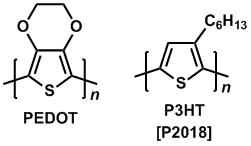TCI使用Cookie來個性化和改善您的用戶體驗,您可以訪問我們的私權政策 了解更多信息。
Notice of Discontinuing the Use of Password-Protected Compressed Files | Product Document Searching Made Easy by 2D Code! | TCI Chemistry News February 2025 | [Product Highlights] Electron-Selective SAM Formation Reagent for... | Various analytical charts can be searched on each product detail page and Product Document Search (The kinds of analytical charts differ by product)
臺幣價格即日起上線!
Maximum quantity allowed is 999
请选择数量
Polymer/Macromolecule Semiconductor Building Blocks
Polyacetylenes exhibit semiconducting-insulating properties by a lack of free electrons (carriers), although there are conducting pathways through π-conjugations. Shirakawa, MacDiarmid and Heeger et al. in 1977 observed that polyacetylenes show high electrical conduction comparable with a metal when the insulating polyacetylenes obtain carriers by a bromine doping.1) After their observation, studies of conducting polymers were dramatically enhanced, and some of the representative polymers were practical for electronic equipment.
In 1990s, an organic light-emitting diode (OLED) of polyphenylene vinylene (PPV) was reported and then semiconducting polymers attracted us in this research area.2) The PPV is one of the light-emitting polymers (LEP) and the functionality is due to the semiconducting property of a π-conjugated polymer without a chemical doping. A chemical modification of a π-conjugated polymer can create various colored emissions. For instance, polyfluorenes (PFO),3) PPVs4) and regiorandom poly(3-octylthiophene) (P3OT)5) exhibit blue, green and red emissions, respectively.

Recent research on organic electronics developed sulfur-containing polymers such as polythiophene. Poly(3,4-ethylenedioxythiophene) (PEDOT) is useful for a capacitor, organic transistor, hole transport material for an OLED device, and secondary battery as well as for an actuator, sensor and thermoelectric conversion element.6,7) PEDOT/PSS that is mixture of PEDOT and polystyrene sulfonate (PSS), is widely used as a hole transport material for organic photovoltaics (OPV).8) Poly(3-hexyl)thiophene (P3HT) can be blended with fullerene derivatives (eg. PCBM) to form an efficient bulk heterojunction. The polymer for the OPV device works as a p-type semiconductor with light absorption.

On the other hand, some thiophene-based polymers exhibit a high energy level of the highest occupied molecular orbital (HOMO), because they are electron-rich. One problem of the thiophene-based polymers is their sensitivity for electrochemical oxidation. In order to solve the problem, one can combine an electron-rich monomer (donor) and an electron-deficient monomer (acceptor) to decrease the HOMO energy level and then stable donor-acceptor (DA type) polymers can be produced.10-12) The DA type polymer usually shows a low band gap state which can absorb light of long wavelength. Furthermore, several DA type polymers are ambipolar enabling both p- and n-dopes.13,14)

Related Categories
References
- 1) H. Shirakawa, E. J. Louis, A. G. MacDiarmid, C. K. Chiang, A. J. Heeger, J. Chem. Soc., Chem. Comm. 1977, 578.

- 2) J. H. Burroughes, D. D. C. Bradley, A. R. Brown, R. N. Marks, K. Mackay, R. H. Friend, P. L. Burns, A. B. Holmes, Nature 1990, 347, 539.

- 3) A. W. Grice, D. D. C. Bradley, M. T. Bernius, M. Inbasekaran, W. W. Wu, E. P. Woo, Appl. Phys. Lett. 1998, 73, 629.

- 4) Review: A. B. Holmes, D. D. C. Bradley, A. R. Brown, P. L. Burn, J. H. Burroughes, R. H. Friend, N. C. Greenham, R. W. Gymer, D. A. Halliday, R. W. Jackson, A. Kraft, J. H. F. Martens, K. Pichler, I. D. W. Samuel, Synth. Met. 1993, 57, 4031.

- 5) D. Braun, G. Gustafsson, D. McBranch, A. J. Heeger, J. Appl. Phys. 1992, 72, 564.

- 6) Review: L. Groenendaal, F. Jonas, D. Freitag, H. Pielartzik, J. R. Reynolds, Adv. Mater. 2000, 12, 481.

- 7) A. Elschner, S. Kirchmeyer, W. Lovenich, U. Merker, K. Reuter, in PEDOT: Principles and Applications of an Intrinsically Conductive Polymer, CRC Press, 2010.
- 8) Review: C. Winder, N. S. Sariciftci, J. Mater. Chem. 2004, 14, 1077.

- 9) Review: M. T. Dang, L. Hirsch, G. Wantz, Adv. Mater. 2011, 23, 3597.

- 10) Y. Liang, Z. Xu, J. Xia, S.-T. Tsai, Y. Wu, G. Li, C. Ray, L. Yu, Adv. Mater. 2010, 22, E135.

- 11) N. Blouin, A. Michaud, M. Leclerc, Adv. Mater. 2007, 19, 2295.

- 12) P. M. Beaujuge, W. Pisula, H. N. Tsao, S. Ellinger, K. Müllen, J. R. Reynolds, J. Am. Chem. Soc. 2009, 131, 7514.

- 13) H. Ito, T. Iwata, S. Watanabe, S. Kuroda, Appl. Phys. Express 2013, 6, 051601.

- 14) S. Cho, J. H. Seo, G.-H. Kim, J. Y. Kim, H. Y. Woo, J. Mater. Chem. 2012, 22, 21238.

Explore Polymer/Macromolecule Semiconductor Building Blocks Categories
- 首頁
- Products
- Materials Science
- Material Building Blocks
- Polymer/Macromolecule Semiconductor Building Blocks